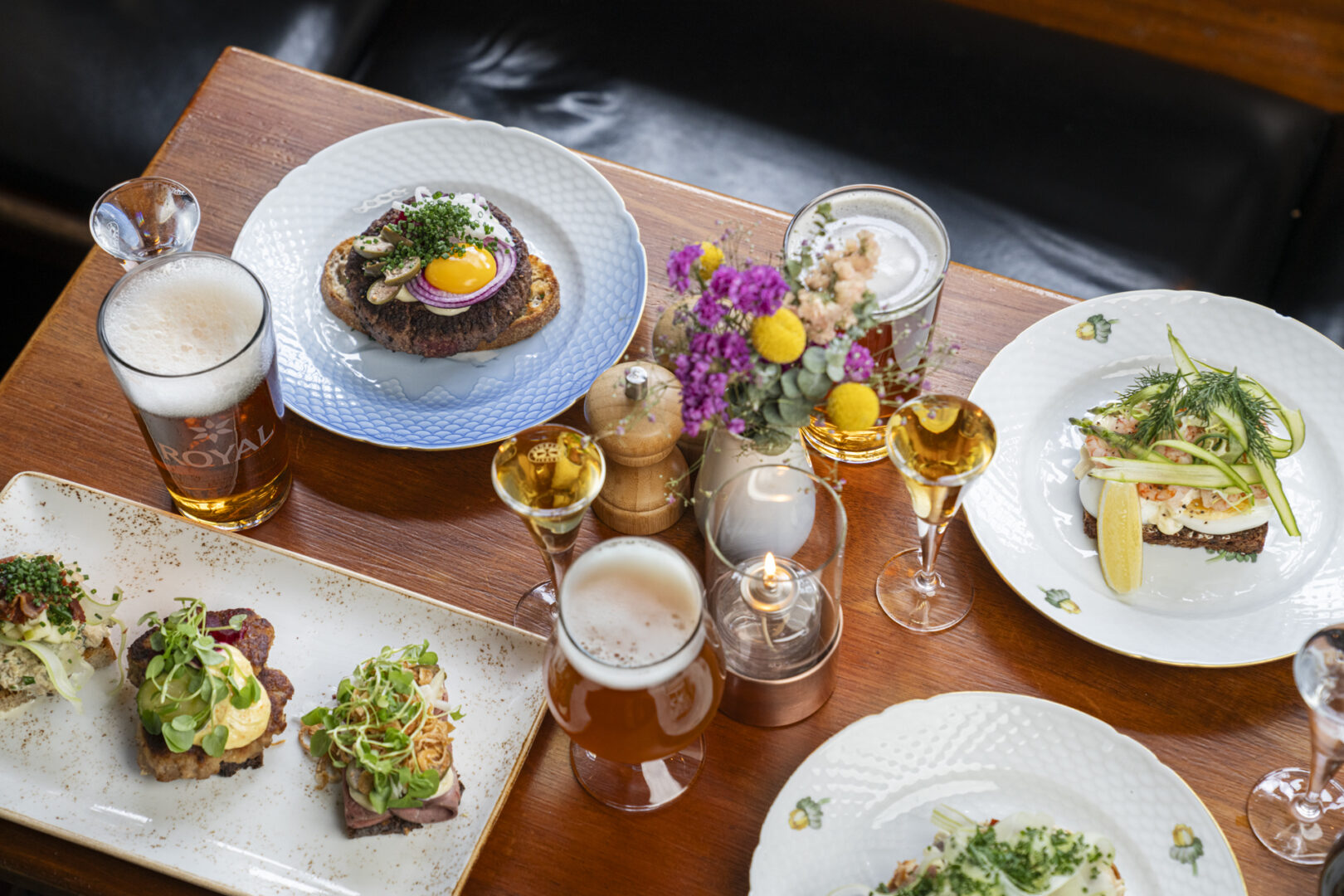Find os
Åbningstider
Restaurantents åbningstider:
Søndag – Torsdag: 9.00 – 00.00
Fredag – Lørdag: 9.00 – 02.00
Køkkenets åbningstider:
Morgenmad: 9.00-11.00
Frokost: 11.00-16.00
Aftensmad: 17.00-22.00
Alle dage 11.00-16:00
I Nyhavns historiske rammer, servere vi traditionelt højtbelagt smørrebrød med et smil og en kæk kommentar.
Aktuelt lige nu
Uforglemmelige oplevelser i historiske omgivelser – det perfekte sted for en charmerende oplevelse.
249
249
139
Remoulade & Kapers
149
Citronmayo & Asparges
139
Citronmayo & Asparges
139
Æg, Kapers & Rødløg
139
Dijonnaise, Æble & Rødløg
199
Paneret Rødspætte, Torsk, Rejer & Ørredrogn
139
Peberrodsmayo, Kapers, Syltede- & Ristede Løg
139
Æble, Blegselleri & Bacon
139
Remoulade, Syltet Agurk & Rødbede
159
Dijonnaise, Syltede Sennepskorn, Syltede Løg & Æggeblomme
199
Peberrodsmayo, Rødløg, Kapers, Rødbede & Æggeblomme
139
Rygeost, Radiser, Ristede Løg & Karse
139
Citronmayo, Boghvedekerner & Brøndkarse
199
Ost, Tomat, Syltede løg, Syltede agurk & Burgerdressing
199
Remoulade, Syltede Rødbeder, Ristede Løg, Syltet Agurk, Syltet Løg & Brun Sovs
199
Fritter & Tartar Sauce
199
Høns i Asparges, Asier & Persille
69
Hjemmelavet mayonnaise
69
Vinagrette, Vesterhavsost & Boghvedekerner
129
Fløde & Bær
129
Rabarber, Mandler & Vaniljeis
139
Hybenkompot, Valnødder & Kerneknækkere
149
129
129
69
249
249
139
Remoulade & Kapers
149
Citronmayo & Asparges
139
Citronmayo & Asparges
139
Æg, Kapers & Rødløg
139
Dijonnaise, Æble & Rødløg
199
Paneret Rødspætte, Torsk, Rejer & Ørredrogn
139
Peberrodsmayo, Kapers, Syltede- & Ristede Løg
139
Æble, Blegselleri & Bacon
139
Remoulade, Syltet Agurk & Rødbede
159
Dijonnaise, Syltede Sennepskorn, Syltede Løg & Æggeblomme
199
Peberrodsmayo, Rødløg, Kapers, Rødbede & Æggeblomme
139
Friskost Mayonnaise, Grøn Olie, Hasselnød & Karse
139
Urtecreme, Vesterhavsost & Brøndkarse
199
Ost, Tomat, Syltede løg, Syltede agurk & Burgerdressing
199
Remoulade, Syltede Rødbeder, Ristede Løg, Syltet Agurk, Syltet Løg & Brun Sovs
199
Fritter & Tartar Sauce
199
Høns i Asparges, Asier & Persille
69
Hjemmelavet mayonnaise
69
Vinagrette, Vesterhavsost & Boghvedekerner
129
Vaniljecrème, Æblekompot, Crumble & Ribsgelé
129
Rabarber, Mandler & Vaniljeis
139
Hybenkompot, Valnødder & Kerneknækkere
149
129
129
69
249
249
139
Remoulade & Kapers
149
Citronmayo & Asparges
139
Citronmayo & Asparges
139
Løg, Æble, Kapers & Karse
199
Paneret Rødspætte, Torsk, Rejer & Ørredrogn
139
Dijonnaise, Sennepskorn, Løg & Rødbede
139
Dijonnaise, Syltet Rødkål, Syltet Agurk, Valnød & Appelsin
139
Æble, Blegselleri & Bacon
139
Remoulade, Syltet Agurk & Rødbede
159
Bacon, svampe & Rødbeder
199
Peberrodsmayo, Rødløg, Kapers, Rødbede & Æggeblomme
139
Friskost Mayonnaise, Grøn Olie, Hasselnød & Karse
139
Citronmayo, Æble & Brøndkarse
189
Burgerdressing, Tomat, Syltet løg, Syltet agurk. Tilvælg Ost & Bacon
189
Flæskesteg, Remoulade, Mayonaise, Syltet Agurk, Syltet Rødløg
199
Fritter & Tartar Sauce
179
Røget Bacon & Surdejsbrød
199
Høns i Asparges, Asier & Persille
69
Hjemmelavet mayonnaise
69
Vinagrette, Vesterhavsost & Boghvedekerner
129
Kirsebærsauce & Crumble
129
Hindbærcrème, Mandler & Vaniljeis
139
Hybenkompot, Valnødder & Kerneknækkere
99
Marmelade & Flormelis
149
129
129
69
249
249
139
Remoulade & Kapers
149
Citronmayo & Asparges
139
Citronmayo & Asparges
139
Æg, Kapers & Rødløg
139
Dijonnaise, Æble & Rødløg
199
Paneret Rødspætte, Torsk, Rejer & Ørredrogn
139
Peberrodsmayo, Kapers, Syltede- & Ristede Løg
139
Æble, Blegselleri & Bacon
139
Remoulade, Syltet Agurk & Rødbede
159
Dijonnaise, Syltede Sennepskorn, Syltede Løg & Æggeblomme
199
Peberrodsmayo, Rødløg, Kapers, Rødbede & Æggeblomme
139
Rygeost, Radiser, Ristede Løg & Karse
139
Citronmayo, Æble & Brøndkarse
199
Ost, Tomat, Syltede løg, Syltede agurk & Burgerdressing
199
Remoulade, Syltede Rødbeder, Ristede Løg, Syltet Agurk, Syltet Løg & Brun Sovs
199
Fritter & Tartar Sauce
199
Høns i Asparges, Asier & Persille
69
Hjemmelavet mayonnaise
69
Vinagrette, Vesterhavsost & Boghvedekerner
129
Vaniljecrème, Æblekompot, Crumble & Ribsgelé
129
Hindbærcrème, Mandler & Vaniljeis
139
Hybenkompot, Valnødder & Kerneknækkere
149
129
129
69

I takt med at industrialiseringen rammer Danmark, opstår traditionen “Smørrebrød”. Mændene skulle have madpakker med på arbejde, og her fik de altså smørrebrød, som var en praktisk løsning til madpakken. Ordet smørrebrød kommer af ‘smør på brød’, altså at putte smør eller fedt på brødskiver.
I 1880’erne begynder smørrebrødet at indtage de danske restauranter med storm, hvor de innovativt går til værk med det, og virkelig begynder at vise hvad smørrebrødet kan.
Siden da har smørrebrødet været en dansk klassiker, som er blevet kendt hele verden over. Og spørger du os, så er smørrebrød i Nyhavn det helt rigtige sted at opleve de danske klassikere.
Skulle der være spørgsmål eller brug for yderligere assistance, kan vi kontaktes på: booking@hyttefadet.dk eller på tlf. +45 33 12 01 07